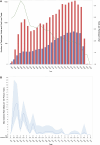Antiretroviral Therapy Within 2 Years of HIV Acquisition Is Associated With Fewer Viral Blips: A Retrospective Analysis of More Than 20 Years of Data From the US Military HIV Natural History Study
- PMID: 40059621
- PMCID: PMC12497960
- DOI: 10.1093/cid/ciaf103
Antiretroviral Therapy Within 2 Years of HIV Acquisition Is Associated With Fewer Viral Blips: A Retrospective Analysis of More Than 20 Years of Data From the US Military HIV Natural History Study
Abstract
Background: Viral blips have been associated with larger reservoir size and slower decay. Earlier antiretroviral therapy (ART) initiation may decrease the risk of blips.
Methods: We analyzed participants from the US Military HIV Natural History Study with an estimated human immunodeficiency virus (HIV) seroconversion date, viral suppression ≤400 copies/mL within 1 year after starting ART, and at least 3 HIV RNA measurements after suppression. A blip was defined as HIV RNA 401-1000 copies/mL preceded and followed by HIV RNA ≤400 copies/mL without changing ART. Cox proportional hazards models were used to estimate hazard ratios (HRs) and 95% confidence intervals (CIs) for factors potentially associated with the time from viral suppression to first blip.
Results: From 1996 through 2022, among 1413 participants on stable suppressive ART, 88 (6.2%) had at least one blip, including 68 (77.3%) with only a single blip. The overall incidence was 1.2 blips per 100 person-years (95% CI: .9-1.4). In multivariable modeling, ART initiation within 24 months of estimated HIV acquisition was independently associated with decreased hazard of viral blips compared with ART initiation after more than 24 months (0-6 months HR: 0.29 and 95% CI: .18-.48; 6-12 months HR: 0.43 and 95% CI: .31-.59; 12-24 months HR: 0.46 and 95% CI: .35-.60).
Conclusions: Participants who initiated ART within 2 years of HIV acquisition had lower hazard of blips, potentially reflecting smaller reservoir size and suggesting reservoir plasticity that extends beyond the acute phase of HIV.
Keywords: acquired immunodeficiency syndrome; anti-HIV agents; antiretroviral agents; reservoir; viremia.
Published by Oxford University Press on behalf of Infectious Diseases Society of America 2025.
Figures



References
-
- Lima V, Harrigan R, Montaner JS. Increased reporting of detectable plasma HIV-1 RNA levels at the critical threshold of 50 copies per milliliter with the TaqMan assay in comparison to the Amplicor assay. J Acquir Immune Defic Syndr 2009; 51:3–6. - PubMed
-
- Garrett NJ, Apea V, Nori A, et al. Comparison of the rate and size of HIV-1 viral load blips with Roche COBAS TaqMan HIV-1 versions 1.0 and 2.0 and implications for patient management. J Clin Virol 2012; 53:354–5. - PubMed
-
- Goupil de Bouille J, Collignon M, Capsec J, et al. Low-level HIV viremia is associated with low antiretroviral prescription refill rates and social deprivation. AIDS Care 2021; 33:1445–50. - PubMed
MeSH terms
Substances
Grants and funding
LinkOut - more resources
Full Text Sources
Medical

